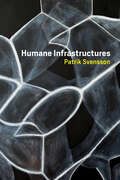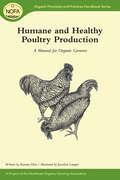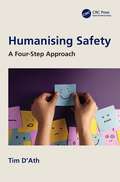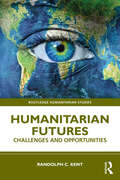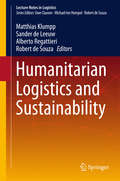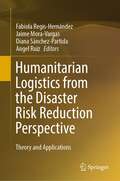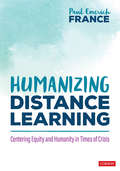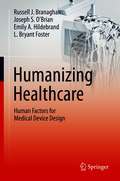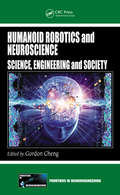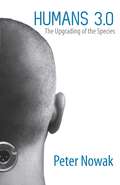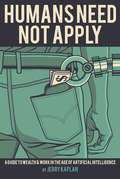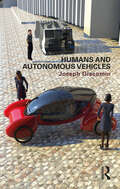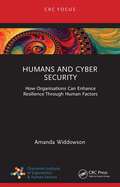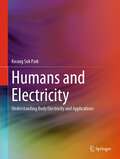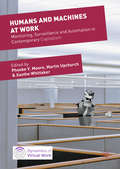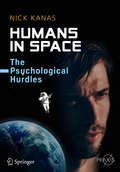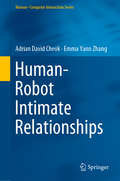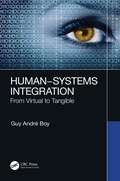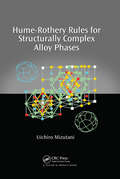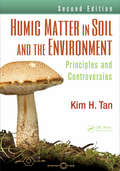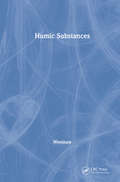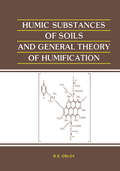- Table View
- List View
Humane Infrastructures (metaLAB Projects)
by Patrik SvenssonHow we can work together to understand, imagine, and build humane infrastructures and a better world.Humane Infrastructures is a deep journey into humanistic and humane knowledge and how it can be engaged to help us collaboratively respond in ethical and sustainable ways to our current global challenges. Patrik Svensson takes the reader through a series of examples, case studies, experiments, and lively dialogues to reconsider infrastructure. He brings people, ideas, and perspectives in through a set of documents and documented experiences, some of which draw from the author&’s practice in Umeå, Stockholm, New York City, and Los Angeles. And he proposes frameworks, such as the idea of an infrastructure clinic, exploring them in staged dialogues and thought experiments.Imagining and building humane infrastructures require us to challenge the very nature of infrastructure, not necessarily all at once but rather step by step. The author consequently engages with infrastructure as a concept and frames it historically, critically, and creatively with research infrastructure as a central case study. He also considers integrative niches for humanities-related work, such as environmental humanities and disability studies, as sites for critical and constructive engagement with infrastructures, including the university itself. In the end, the exploration leads to a reimagination of the humanities and, more generally, higher education as part of a capacious public-facing effort of world-(re)building.The book will appeal to scholars in the humanities and a range of intersecting fields, such as infrastructure studies, critical computing, and design.
Humane and Healthy Poultry Production: A Manual for Organic Growers
by Karma GlosOrganic poultry production systems can be sophisticated, technically advanced commercial operations or simple, small-farm add-ons integrated into a more complex agroecosystem. No matter the size or scale, the basic tenets of traditional organic agriculture apply. This NOFA guide includes information on:Organic poultry basicsEstablishing the facilities (housing and equipment, choosing and using litter, outdoor access, brooding, grazing and pasturing)Purchasing and brooding chicksOrganic feed and supplementsPoultry health care in the organic systemManagement challenges (production and culling, spotted shells, yolk color)Slaughter and ProcessingMarketingProduction expectations and economic viability
Humanising Safety: A Four-Step Approach
by Tim D'AthThe world of safety for professionals can often be unclear. In an industry that divides the safety world into one of two camps, either traditional or contemporary safety, the lack of knowledge continues to propagate through books, publications, podcasts, social media, and conferences, leaving safety professionals feeling more muddled than informed.Humanising Safety: A Four-Step Approach provides a practical approach to human-centric safety collating the best elements of traditional and contemporary approaches for safety professionals to practise at work. By following this approach, readers will learn to apply humanistic safety principles to any workplace where safety is valued. This book explores the realm of human-centric safety and its intricacies, unpacking topics such as the contradictions and dilemmas of workplace safety, the psychology of safety, the human condition and its contribution to the safety of work, and how safety leaders can synthesise the collective knowledge, skills, expertise, and lived experiences of the people who make up an organisation. Featuring micro-projects for readers to refer to and work through within their organisations, this book allows the reader to navigate the vast sea of information surrounding the opportunities and pitfalls of traditional and contemporary safety approaches through a lens of human-centric safety.This is an easy-to-read book that will appeal to professionals at all career levels where safety is critical to their role, including those in construction, utilities, manufacturing, mining, civil, aviation, and maritime sectors.
Humanitarian Futures: Challenges and Opportunities (Routledge Humanitarian Studies)
by Randolph C. KentHumanitarian Futures: Challenges and Opportunities explores the increasing types, dimensions and dynamics of crises threatening the world in the twenty-first century, and argues that those with humanitarian roles and responsibilities can only meet such challenges if their approaches to strategic and operational planning undergo fundamental paradigmatic shifts. Strategically and operationally, such shifts must begin by planning from the future, for the future.Author Randolph C. Kent, the UN’s first Humanitarian Coordinator, with experience in some of the most complex crises of modern times, including Rwanda, Ethiopia, Kosovo, Sudan and Somalia, provides a blueprint for dealing with ever greater complexity on planet Earth and beyond. That blueprint is not about upgrading existing tools or relying upon tried precedence. Rather, it points to a new paradigm for meeting crises. It begins by looking at the changing nature of humanness and governance, and then turns to plausible future crises based on such changes, before concluding with practical steps for dealing with ever more complex humanitarian threats, now and in the future.This book will be an essential read for humanitarian policymakers and practitioners as well as for humanitarian and global studies researchers and students who are and want to be engaged in understanding and preparing for ever more complex and unpredictable humanitarian challenges.
Humanitarian Logistics and Sustainability
by Matthias Klumpp Sander Leeuw Alberto Regattieri Robert SouzaThis contributed volume combines conceptual and strategic research articles dealing with the "why" and "to what end" of sustainable operations in humanitarian logistics, as well as operational research contributions regarding the "how" from the United Nations as well as from researchers and organizations from different countries (Germany, Australia, Singapore, Netherlands, Italy, Denmark, Jordan). The target audience primarily comprises research experts, decision makers and practitioners in the field, but the book may also be beneficial for graduate students.
Humanitarian Logistics from the Disaster Risk Reduction Perspective: Theory and Applications
by Angel Ruiz Diana Sánchez-Partida Fabiola Regis-Hernández Jaime Mora-VargasThis book aims to clarify the priorities of the Sendai Framework for the DRR 2015 – 2030, through gathering recent contributions addressing the different ways researchers define, measure, reduce, and manage risk in the challenge of the DRR. Beyond a discussion of the different definitions of disaster risk; this book provides contributions focused on optimization approaches that support the decision-making process in the challenge of managing DRR problems considering emerging disaster risks in the medium and long term, as well as national and local applications. Some of the topics covered include network flow problems, stochastic optimization, discrete optimization, multi-objective programming, approximation techniques, and heuristic approaches.The target audience of the book includes professionals who work in Linear Programming, Logistics, Optimization (Mathematical, Robust, Stochastic), Management Science, Mathematical Programming, Networks, Scheduling, Simulation, Supply Chain Management, Sustainability, and similar areas. It can be useful for researchers, academics, graduate students, and anyone else doing research in the field
Humanities and Sustainability from Glocal Perspectives Towards Future Earth: Proceedings of IGU Thematic Conference 2022, India (Advances in Geographical and Environmental Sciences)
by Manish Kumar Pankaj Kumar Subhash Anand Dinesh Kumar Tripathi Naresh Kumar VermaThis book presents selected papers from the International Geographical Union (IGU) Thematic Conference 2022, which was held at the Central University of Haryana, Mahendragarh, India, November 24–25, 2022. The theme of the conference was Sustainability, Future Earth, and Humanities: Opportunities and Challenges. Focusing on the humanities, the book shares advanced research and innovative approaches that illuminate significant discoveries concerning integrated glocal (global-local) perspectives on sustainability. The integration of humanities and glocal perspectives has become crucial to ensure a sustainable future for our planet. To achieve a thriving future, it is essential to bridge the gap between scientific knowledge and human values, while acknowledging the interconnectedness of local and global dynamics. The humanities contribute a distinct dimension to sustainability by offering cultural, ethical, and historical insights. Glocal perspectives, on the other hand, underscore the interdependence of our planet's ecosystems and human societies. They advocate for a dual focus on local contexts and global implications, recognizing that environmental challenges such as climate change, deforestation, loss of biodiversity, and pollution manifest differently in various regions due to diverse socio-economic, political, and cultural factors. The integration of the humanities and sustainability encourages a transformative shift towards more ethical and responsible behavior, fostering a sense of stewardship for the environment. The book includes a wide range of topics, focusing extensively on the potential contributions of humanities towards the goal of long-term sustainability. The topics covered in this book encompass in-depth analyses of various subjects, such as environment and society, social dynamics, human development, urban landscape dynamics, rural-urban inequality, gender inequality, gender-environment relationships, entrepreneurship, public health, COVID-19 management and its spatiotemporal aspects, and geopolitics, among others. The book discusses both global and local perspectives on these important issues. Consequently, the knowledge and innovation presented in the book make a substantial academic contribution and facilitate to achieve sustainability, both at local and global levels.
Humanizing Distance Learning: Centering Equity and Humanity in Times of Crisis
by Paul Emerich France"In some ways, shouldn′t we always be teaching from a distance?" Paul France asks this not as pitch for distance learning. But because part of the reason distance learning has been so challenging, Paul asserts, is that we’re replicating long-standing practices that promote dependent learning in our students. Why not use this unique moment of time to reconnect with the true purpose of teaching: to help our students become liberated learners and free thinkers? The next logical step in teachers’ months-long distance learning "journey," Humanizing Distance Learning describes how to center humanity and equity in our process of reimagining learning. Even while teaching and learning miles apart through screens, you’ll discover how to Build independence within your students so they’re better equipped to tackle challenges with persistence and learn how to learn Make collaboration and human connection essential components of your pedagogy, offering students the chance to socialize and learn from one another Center and unpack students’ identities, helping them develop a conscious knowledge of themselves, all the while using their self-identified strengths to overcome any obstacles Plan, prepare, and implement humanized instruction while teaching for student liberation—both digitally and in person. Investigate technology integration, including the Digital Divide, as well as ways to minimize EdTech integration so that our collective sense of humanity can continue to be front and center "The future," Paul writes, "may be unclear, the road may be rocky, and the story may continue to be long and winding as we push forward through this global crisis. But the answer will always be simple: We must teach and learn in pursuit of a deeper sense of collective humanity—and for no other reason." "This book is equal parts visionary and practical, courageous and invitational. It addresses foundational needs and wrenching challenges teachers faced during the recent time when U.S. teachers abruptly found themselves teaching remotely. . . . It is a deeply humanizing book." ~Carol Ann Tomlinson, William Clay Parrish, Jr. Professor Emeritus, University of Virginia "Humanizing Distance Learning is a book for our times not only because it addresses how to build a culture of thinking and teach for understanding at a distance, but also because it challenges the status quo of education by offering a more liberated and humane vision." ~Ron Ritchhart, Senior Research Associate, Harvard Graduate School of Education "Paul France has produced a timely and necessary book that will help educators humanize distance learning. Recognizing incredible dimensions of complexity, this book will surely help educators traverse times of uncertainty in distance learning."</spa
Humanizing Distance Learning: Centering Equity and Humanity in Times of Crisis
by Paul Emerich France"In some ways, shouldn′t we always be teaching from a distance?" Paul France asks this not as pitch for distance learning. But because part of the reason distance learning has been so challenging, Paul asserts, is that we’re replicating long-standing practices that promote dependent learning in our students. Why not use this unique moment of time to reconnect with the true purpose of teaching: to help our students become liberated learners and free thinkers? The next logical step in teachers’ months-long distance learning "journey," Humanizing Distance Learning describes how to center humanity and equity in our process of reimagining learning. Even while teaching and learning miles apart through screens, you’ll discover how to Build independence within your students so they’re better equipped to tackle challenges with persistence and learn how to learn Make collaboration and human connection essential components of your pedagogy, offering students the chance to socialize and learn from one another Center and unpack students’ identities, helping them develop a conscious knowledge of themselves, all the while using their self-identified strengths to overcome any obstacles Plan, prepare, and implement humanized instruction while teaching for student liberation—both digitally and in person. Investigate technology integration, including the Digital Divide, as well as ways to minimize EdTech integration so that our collective sense of humanity can continue to be front and center "The future," Paul writes, "may be unclear, the road may be rocky, and the story may continue to be long and winding as we push forward through this global crisis. But the answer will always be simple: We must teach and learn in pursuit of a deeper sense of collective humanity—and for no other reason." "This book is equal parts visionary and practical, courageous and invitational. It addresses foundational needs and wrenching challenges teachers faced during the recent time when U.S. teachers abruptly found themselves teaching remotely. . . . It is a deeply humanizing book." ~Carol Ann Tomlinson, William Clay Parrish, Jr. Professor Emeritus, University of Virginia "Humanizing Distance Learning is a book for our times not only because it addresses how to build a culture of thinking and teach for understanding at a distance, but also because it challenges the status quo of education by offering a more liberated and humane vision." ~Ron Ritchhart, Senior Research Associate, Harvard Graduate School of Education "Paul France has produced a timely and necessary book that will help educators humanize distance learning. Recognizing incredible dimensions of complexity, this book will surely help educators traverse times of uncertainty in distance learning."</spa
Humanizing Healthcare – Human Factors for Medical Device Design
by Russell J. Branaghan Joseph S. O’Brian Emily A. Hildebrand L. Bryant FosterThis book introduces human factors engineering (HFE) principles, guidelines, and design methods for medical device design. It starts with an overview of physical, perceptual, and cognitive abilities and limitations, and their implications for design. This analysis produces a set of human factors principles that can be applied across many design challenges, which are then applied to guidelines for designing input controls, visual displays, auditory displays (alerts, alarms, warnings), and human-computer interaction. Specific challenges and solutions for various medical device domains, such as robotic surgery, laparoscopic surgery, artificial organs, wearables, continuous glucose monitors and insulin pumps, and reprocessing, are discussed. Human factors research and design methods are provided and integrated into a human factors design lifecycle, and a discussion of regulatory requirements and procedures is provided, including guidance on what human factors activities should be conducted when and how they should be documented.This hands-on professional reference is an essential introduction and resource for students and practitioners in HFE, biomedical engineering, industrial design, graphic design, user-experience design, quality engineering, product management, and regulatory affairs.Teaches readers to design medical devices that are safer, more effective, and less error prone;Explains the role and responsibilities of regulatory agencies in medical device design;Introduces analysis and research methods such as UFMEA, task analysis, heuristic evaluation, and usability testing.
Humanoid Robotics and Neuroscience: Science, Engineering and Society
by Gordon ChengHumanoid robots are highly sophisticated machines equipped with human-like sensory and motor capabilities. Today we are on the verge of a new era of rapid transformations in both science and engineering-one that brings together technological advancements in a way that will accelerate both neuroscience and robotics. Humanoid Robotics and Neuroscienc
Humans 3.0: The Upgrading of the Species
by Peter NowakLife for early humans wasn&’t easy. They may have been able to walk on two feet and create tools 4 million years ago, but they couldn&’t remember or communicate. Fortunately, people got smarter, and things got better. They remembered on-the-spot solutions and shared the valuable information of their experiences. Clubs became swords, caves became huts, and fires became ovens. Collectively these new tools became technology. As the 21st century unfolds, the pace of innovation is accelerating exponentially. Breakthroughs from robotics to genetics appear almost on a daily basis. It&’s all happening so quickly that it&’s hard to keep track—but recently there&’s been a shift. We used to create technology to change the world around us; now we&’re using it to change ourselves. With vaccinations, in-vitro fertilization, and individual genetic therapy, we&’re entering a new epoch, a next step, faster and more dramatic than the shift from Australopithicines to Homo Sapiens. The technology that set us apart from our earliest selves is becoming part of the evolutionary process. Advancements in computing, robotics, nanotechnology, neurology, and genetics mean that our wildest imaginings could soon become commonplace. Peter Nowak deftly presents the potential outcomes—both exciting and frightening—of key, rapidly advancing technologies and adroitly explores both the ramifications of adopting them and what doing so will reveal about the future of our species. We&’ve come a long way in 4 million years. Welcome to Human 3.0.
Humans Need Not Apply: A Guide to Wealth & Work in the Age of Artificial Intelligence
by Jerry KaplanAn &“intriguing, insightful&” look at how algorithms and robots could lead to social unrest—and how to avoid it (The Economist, Books of the Year). After decades of effort, researchers are finally cracking the code on artificial intelligence. Society stands on the cusp of unprecedented change, driven by advances in robotics, machine learning, and perception powering systems that rival or exceed human capabilities. Driverless cars, robotic helpers, and intelligent agents that promote our interests have the potential to usher in a new age of affluence and leisure—but as AI expert and Silicon Valley entrepreneur Jerry Kaplan warns, the transition may be protracted and brutal unless we address the two great scourges of the modern developed world: volatile labor markets and income inequality. In Humans Need Not Apply, he proposes innovative, free-market adjustments to our economic system and social policies to avoid an extended period of social turmoil. His timely and accessible analysis of the promises and perils of AI is a must-read for business leaders and policy makers on both sides of the aisle. &“A reminder that AI systems don&’t need red laser eyes to be dangerous.&”—Times Higher Education Supplement &“Kaplan…sidesteps the usual arguments of techno-optimism and dystopia, preferring to go for pragmatic solutions to a shrinking pool of jobs.&”—Financial Times
Humans and Autonomous Vehicles
by Joseph GiacominThis book provides an introduction to the Human Centred Design of autonomous vehicles for professionals and students. While rapid progress is being made in the field of autonomous road vehicles the majority of actions and the research address the technical challenges, with little attention to the physical, perceptual, cognitive and emotional needs of humans. This book fills a gap in the knowledge by providing an easily understandable introduction to the needs and desires of people in relation to autonomous vehicles. The book is "human centred design" led, adding an important human perspective to the primarily technology-driven debates about autonomous vehicles. It combines knowledge from fields ranging from linguistics to electrical engineering to provide a holistic, multidisciplinary overview of the issues affecting the interactions between autonomous vehicles and people. It emphasises the constraints and requirements that a human centred perspective necessitates, giving balanced information about the potential conflicts between technical and human factors. The book provides a helpful introduction to the field of design ethics, to enhance the reader’s awareness and understanding of the multiple ethical issues involved in autonomous vehicle design. Written as an accessible guide for design practitioners and students, this will be a key read for those interested in the psychological, sociological and ethical factors involved in automotive design, human centred design, industrial design and technology.
Humans and Cyber Security: How Organisations Can Enhance Resilience Through Human Factors
by Amanda WiddowsonCyber security incidents are often attributed to “human error”. The discipline of human factors recognises the importance of identifying organisational root causes, rather than focusing on individual actions or behaviours. Humans and Cyber Security: How Organisations Can Enhance Resilience Through Human Factors delivers an applied approach to capturing and mitigating the risk of the human element in cyber security and proposes that it is easier to change organisational practices than it is individual behaviour.This book identifies undesirable behaviours and practices, then analyses why they occur, and finally, offers mitigating actions. Models of behavioural motivations will be discussed alongside individual vulnerabilities. Organisational vulnerabilities will form the main focus of an applied approach to capturing and mitigating the risk of the human element in cyber security. It concludes with recommended processes that involve talking to a range of individuals across the organization. Backed up with practical materials to facilitate data collection, applied examples and mitigating strategies to address known human vulnerabilities, this book offers the reader a complete view of understanding and preventing cyber security breaches.The solutions in this book will appeal to students and professionals of human factors, security, informational technology, human resources and business management.
Humans and Electricity: Understanding Body Electricity and Applications
by Kwang Suk ParkHumans are electric beings. We are managed, monitored, and stimulated electrically. This textbook provides students and practitioners with a solid foundation and understanding of human electricity and the work currently being done to further develop electrical signals for medical purposes and related goals. The book introduces the fundamentals of how biological systems generate electrical signals, covering a wide range of biomedical engineering topics including bioelectricity, biomedical signals, neural engineering, and brain-computer interface. The book is presented in three sections: Part I explains how electrical signals and impulses manage the human body; Part II examines the kinds of electrical signals from the human body and how they are monitored, controlled, and used; Part III looks at clinical use of electrical stimulation toward the human body and how they are being developed for interventions in medicine. The book is also a valuable professional reference for practicing engineers and scientists. Explains humans as electric beings who are managed, monitored, and stimulated electrically;Deals with the electricity of major human organs;Covers a wide range of biomedical engineering topics
Humans and Machines at Work
by Martin Upchurch Phoebe V. Moore Xanthe WhittakerThis edited collection provides a series of accounts of workers' local experiences that reflect the ubiquity of work's digitalisation. Precarious gig economy workers ride bikes and drive taxis in China and Britain; call centre workers in India experience invasive tracking; warehouse workers discover that hidden data has been used for layoffs; and academic researchers see their labour obscured by a 'data foam' that does not benefit them. These cases are couched in historicalaccounts of identity and selfhood experiments seen in the Hawthorne experiments and the lineage of automation. This book will appeal to scholars in the Sociology of Work and Digital Labour Studies and anyone interested in learning about monitoring and surveillance, automation, the gig economy and the quantified self in the workplace.
Humans in Space
by Nick KanasUsing anecdotal reports from astronauts and cosmonauts, and the results from studies conducted in space analog environments on Earth and in the actual space environment, this book broadly reviews the various psychosocial issues that affect space travelers. Unlike other books that are more technical in format, this text is targeted for the general public. With the advent of space tourism and the increasing involvement of private enterprise in space, there is now a need to explore the impact of space missions on the human psyche and on the interpersonal relationships of the crewmembers. Separate chapters of the book deal with psychosocial stressors in space and in space analog environments; psychological, psychiatric, interpersonal, and cultural issues pertaining to space missions; positive growth-enhancing aspects of space travel; the crew-ground interaction; space tourism; countermeasures for dealing with space; and unique aspects of a trip to Mars, the outer solar system, and interstellar travel.
Human–Robot Intimate Relationships (Human–Computer Interaction Series)
by Adrian David Cheok Emma Yann ZhangThe idea of humans falling in love with artificial beings is not a modern conception. Our relationship with artificial partners has come a long way since Pygmalion and his ivory lover. In recent years, there has been a strong upsurge of interest and discussions in the various aspects of intimate relationships between humans and artificial partners. This interest is evidenced by the increase in media coverage, TV documentaries and films on this topic, as well as the active research efforts within the academic community. This book provides a comprehensive collection and overview of the latest development in the field of intimate relationships between humans and artificial partners, in particular robots and virtual agents. It includes relevant research work undertaken by the authors, the latest advancements in technology and commercial products, and future predictions and insights from leading experts in the area. This book contains an in-depth discussion of the engineering, philosophical, psychological, ethical, and sociological implications of relationships with artificial companions. It also gives a glimpse of some future directions of artificial intelligence, human-computer love and sexual interaction, robotics engineering etc. It is a great resource for researchers and professionals working in these areas. The narrative style of the book also makes it an enjoyable and educational read for everyone.
Human–Systems Integration: From Virtual to Tangible
by Guy André BoyHuman–Systems Integration: From Virtual to Tangible Subject Guide: Ergonomics and Human Factors This book is an attempt to better formalize a systemic approach to human–systems integration (HSI). Good HSI is a matter of maturity… it takes time to mature. It takes time for a human being to become autonomous, and then mature! HSI is a matter of human–machine teaming, where human–machine cooperation and coordination are crucial. We cannot think engineering design without considering people and organizations that go with it. We also cannot think new technology, new organizations, and new jobs without considering change management. More specifically, this book is a follow-up of previous contributions in human-centered design and practice in the development of virtual prototypes that requires progressive operational tangibility toward HSI. The book discusses flexibility in design and operations, tangibility of software-intensive systems, virtual human-centered design, increasingly autonomous complex systems, human factors and ergonomics of sociotechnical systems, systems integration, and changed management in digital organizations. The book will be of interest to industry, academia, those involved with systems engineering, human factors, and the broader public.
Humboldt’s Mexico: In the Footsteps of the Illustrious German Scientific Traveller
by Myron EchenbergA study of a gifted scientist and visionary who embodies the spirit of adventure and discovery.
Hume-Rothery Rules for Structurally Complex Alloy Phases
by Uichiro MizutaniWith a history that reaches back some 90 years, the Hume-Rothery rules were developed to provide guiding principles in the search for new alloys. Ultimately, the rules bridged metallurgy, crystallography, and physics in a way that led to the emergence of a physics of the solid state in 1930s, although the physical implications of the rules were nev
Humic Matter in Soil and the Environment: Principles and Controversies, Second Edition (Books in Soils, Plants, and the Environment)
by Kim H. TanThe field of humic matter research has undergone drastic changes in concepts and principles since the first edition of Humic Matter in Soil and the Environment: Principles and Controversies was published more than a decade ago. Still the only book of its kind specifically addressing humic acid principles and controversies, the Second Edition presen
Humic Substances
by Robert L. Wershaw Michael A. MikitaThis book is an introduction and guide to the use of nuclear magnetic resonance (NMR) spectroscopy for the study of humic materials and coals. It provides a general discussion of the application of liquid-state and solid-state NMR techniques.
Humic Substances of Soils and General Theory of Humification
by D.S. OrlovThis work contains results of the latest studies on the composition, structure and properties of humic substances, which are the largest and most important component of organic matter of different types of soils. It should be useful for soil scientists and nature conservationists.
